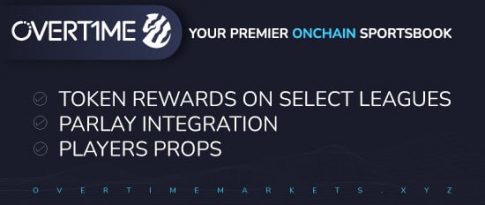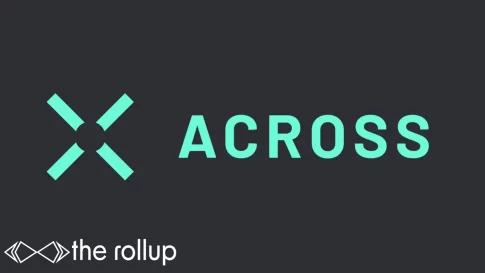
A Deep Dive into Rollups, Their Current Centralized Nature, and the Ongoing Efforts Towards Decentralization.
NFL Season is available to trade on Overtime – Sports market AMM built on Thales Market, a Synthetix ecosystem project. Earn your share of 90k $OP, 90k ARB, and 180k $THALES in incentives. Try it 👉🏽 HERE!
AcrossProtocol is a cross-chain bridge for L2s and rollups secured by UMA’s optimistic oracle that prides itself on its speed, security and low fees. Check it 👉🏽 HERE.
High Rollers:
Welcome to a deep dive into the world of rollups – a technology that’s reshaping Ethereum as we know it. Today, rollups are more centralized than you might think, a trade-off made for immediate feedback loops, accessibility, and user acquisition in the race to scale Ethereum.
Whether you’re familiar with Arbitrum, OptimismFND, or new to rollups, this post is for you.
Discover the tech behind rollups, the quest for L2 decentralization, and the teams leading the charge. Plus, explore the rapid expansion of L2s in the onchain dark forest.
Let’s unravel the mysteries of rollups together👇
Cheers,
The Rollup
𝗥𝗼𝗹𝗹𝘂𝗽𝘀 𝗮𝘀 𝘄𝗲 𝗸𝗻𝗼𝘄 𝘁𝗵𝗲𝗺 𝘁𝗼𝗱𝗮𝘆 𝗮𝗿𝗲 𝗺𝗼𝗿𝗲 𝗰𝗲𝗻𝘁𝗿𝗮𝗹𝗶𝘇𝗲𝗱 𝘁𝗵𝗮𝗻 𝗮𝗻𝘆𝗼𝗻𝗲 𝗰𝗮𝗻 𝗶𝗺𝗮𝗴𝗶𝗻𝗲…
In the quest to scale Ethereum with rollups, decentralization has been put to the backburner in exchange for immediate feedback loops, accessibility and user acquisition.
For better or for worse, the rollup stack today looks far different than the ideal version in the future.
If you’re reading this, you may have heard of rollups before, used @arbitrum or @optimismFND, or perhaps others…but, if you haven’t?
Don’t worry.
In today’s post, you’ll learn about the underlying technology behind rollups, the search for decentralization in the L2 sphere, and several key teams pioneering these initiatives
As we all know, the onchain dark forest is witnessing a rapid expansion of L2s to address the scalability issues of Ethereum.
In the diagram below from @l2beat, you can see there are already 15+ highly active rollup ecosystems with tons of users, transaction activity, and TVL.

I think by EOY, we’ll be at 100+ rollups with thousands of daily active users.
By the end of 2024?
𝗢𝘃𝗲𝗿 𝗼𝗻𝗲 𝘁𝗵𝗼𝘂𝘀𝗮𝗻𝗱. Some highly knowledgable people in the space, like @neelsalami, have put out pieces arguing against this.
In fact, tomorrow I’ll have a piece summarizing Neel’s recent post & also post some counterpoints to his theses.
Gib follow @ayyyeandy to not miss that one tomorrow, then keep reading…
Amidst this Cambrian Explosion of rollups, as quoted by @0xkatz of @Calderaxyz in the most recent DeFi By Design Podcast on @therollupco set to go live this week, a key component of rollups, known as sequencers, has sparked a debate about centralization and decentralization within the ecosystem.
𝘈 𝘩𝘦𝘢𝘭𝘵𝘩𝘺 𝘥𝘦𝘣𝘢𝘵𝘦, 𝘢𝘵 𝘵𝘩𝘢𝘵. First, what are sequencers and why are they important?
Sequencers play a crucial role in the functioning of rollups. They are responsible for ordering transactions within rollups, making the network cheaper, faster, and more user-friendly.
As you can see below, sequencers work on the ordering of TXs and batching into one TX to be posted to Ethereum L1.

𝗪𝗶𝘁𝗵𝗼𝘂𝘁 𝘀𝗲𝗾𝘂𝗲𝗻𝗰𝗲𝗿𝘀, 𝗿𝗼𝗹𝗹𝘂𝗽𝘀 𝘄𝗼𝘂𝗹𝗱 𝗵𝗮𝘃𝗲 𝘁𝗼 𝗿𝗲𝗹𝘆 𝗼𝗻 𝗘𝘁𝗵𝗲𝗿𝗲𝘂𝗺 𝗳𝗼𝗿 𝘀𝗲𝗾𝘂𝗲𝗻𝗰𝗶𝗻𝗴 𝘁𝗿𝗮𝗻𝘀𝗮𝗰𝘁𝗶𝗼𝗻𝘀, 𝘄𝗵𝗶𝗰𝗵 𝘄𝗼𝘂𝗹𝗱 𝗯𝗲 𝗺𝗼𝗿𝗲 𝗲𝘅𝗽𝗲𝗻𝘀𝗶𝘃𝗲 𝗮𝗻𝗱 𝗹𝗲𝘀𝘀 𝗲𝗳𝗳𝗶𝗰𝗶𝗲𝗻𝘁.
However, the use of centralized sequencers is not without its downsides:
‣ 𝗖𝗲𝗻𝘀𝗼𝗿𝘀𝗵𝗶𝗽:
Theoretically, sequencer operators could choose which TXs to include in blocks, and which to exclude. This is not ideal for immutability or trustlessness, two core ethos’ of crypto.
‣ 𝗦𝗶𝗻𝗴𝗹𝗲 𝗽𝗼𝗶𝗻𝘁𝘀 𝗼𝗳 𝗳𝗮𝗶𝗹𝘂𝗿𝗲:
With just one operator in a hardware database somewhere around the world, there is little to no backup. If unforeseen events happen, for example Arbitrum / Offchain labs forgot to add gas money to their sequencer and it stopped processing TXs for sometime (𝘰𝘳 𝘢𝘵 𝘭𝘦𝘢𝘴𝘵, 𝘵𝘩𝘪𝘴 𝘸𝘢𝘴 𝘵𝘩𝘦 𝘳𝘶𝘮𝘰𝘳), then the chain can stop operating effectively.
‣ 𝗠𝗮𝘅𝗶𝗺𝗮𝗹 𝗲𝘅𝘁𝗿𝗮𝗰𝘁𝗮𝗯𝗹𝗲 𝘃𝗮𝗹𝘂𝗲 (𝗠𝗘𝗩) 𝗲𝘅𝘁𝗿𝗮𝗰𝘁𝗶𝗼𝗻:
Due to the fact that sequencers are responsible for TX ordering, preferential treatment is not out of the picture. Sandwich attacks, or frontrunning become real possibilities due to the centralized control of TX ordering.
‣ 𝗣𝗼𝗼𝗿 𝗶𝗻𝘁𝗲𝗿𝗼𝗽𝗲𝗿𝗮𝗯𝗶𝗹𝗶𝘁𝘆:
With just one sequencer, its tough to interoperate with other rollups in a cost-effective fashion. You have to eat all the costs for sequencing and likely data availability as well. Less interop = less liquidity = less users.
These are four major topics to address.
𝗕𝗘𝗙𝗢𝗥𝗘 we enter the solutions segment, I want to highlight that I am still learning about sequencers myself and I am very open to feedback.
𝗔𝗟𝗦𝗢, according to other people much smarter than me, there are much more important challenges facing rollups than sequencers at the moment.
𝘏𝘰𝘸𝘦𝘷𝘦𝘳, 𝘵𝘩𝘦𝘳𝘦 𝘪𝘴 𝘴𝘵𝘪𝘭𝘭 𝘢 𝘨𝘳𝘰𝘸𝘪𝘯𝘨 𝘤𝘢𝘭𝘭 𝘧𝘰𝘳 𝘮𝘰𝘳𝘦 𝘥𝘦𝘤𝘦𝘯𝘵𝘳𝘢𝘭𝘪𝘻𝘦𝘥 𝘴𝘰𝘭𝘶𝘵𝘪𝘰𝘯𝘴…
𝗧𝘄𝗼 𝗽𝗿𝗶𝗺𝗮𝗿𝘆 𝗮𝗽𝗽𝗿𝗼𝗮𝗰𝗵𝗲𝘀 𝗵𝗮𝘃𝗲 𝗲𝗺𝗲𝗿𝗴𝗲𝗱: 𝘀𝗵𝗮𝗿𝗲𝗱 𝘀𝗲𝗾𝘂𝗲𝗻𝗰𝗲𝗿𝘀 𝗮𝗻𝗱 𝗱𝗶𝗿𝗲𝗰𝘁 𝗱𝗲𝗰𝗲𝗻𝘁𝗿𝗮𝗹𝗶𝘇𝗲𝗱 𝘀𝗲𝗾𝘂𝗲𝗻𝗰𝗲𝗿𝘀.
Shared sequencers refer to a network of sequencers that service multiple rollups. They sort out transactions and create a mega block from which individual rollups derive their blocks.
This approach promotes interoperability and composability between rollups, as they can all utilize the shared sequencing layer.

(𝘪𝘮𝘢𝘨𝘦 𝘧𝘳𝘰𝘮 @CelestiaOrg, reminder: make sure to claim your $TIA before Oct. 17th!)
One of the prominent shared sequencer networks going live very soon is@EspressoSys. Espresso is aiming to achieve lower costs and greater decentralizations for teams which choose to utilize their network of shared sequencers.
On the other hand, direct decentralized sequencing involves each rollup having its own set of sequencers. This approach allows rollups to design mechanisms that cater specifically to their needs. It also makes it easier for network participants to work together, as they operate within their own ecosystems.
Both shared and direct decentralized sequencing have their merits and drawbacks.
Shared sequencing can save rollups the hassle of setting up their own sequencing node army and promote better liquidity across rollups.
However, it is still limited by the L1’s data and transaction ordering throughput. Direct decentralized sequencing allows for more customization and control, but it can be harder to bootstrap and may isolate rollups from each other.
As you can see the diagram below, the tradeoffs between trustlessness and functionality is highlighted.
Shared sequencers appear to be the outlier…

𝘛𝘩𝘦 𝘤𝘩𝘰𝘪𝘤𝘦 𝘣𝘦𝘵𝘸𝘦𝘦𝘯 𝘴𝘩𝘢𝘳𝘦𝘥 𝘢𝘯𝘥 𝘥𝘪𝘳𝘦𝘤𝘵 𝘥𝘦𝘤𝘦𝘯𝘵𝘳𝘢𝘭𝘪𝘻𝘦𝘥 𝘴𝘦𝘲𝘶𝘦𝘯𝘤𝘪𝘯𝘨 𝘸𝘪𝘭𝘭 𝘥𝘦𝘱𝘦𝘯𝘥 𝘰𝘯 𝘵𝘩𝘦 𝘴𝘱𝘦𝘤𝘪𝘧𝘪𝘤 𝘯𝘦𝘦𝘥𝘴 𝘰𝘧 𝘦𝘢𝘤𝘩 𝘳𝘰𝘭𝘭𝘶𝘱.
Rollups with complex features may prefer direct decentralized sequencers, while lightweight rollups may opt for shared sequencing. As the rollup ecosystem continues to evolve, it is clear that the future will see a mix of both approaches.
𝗧𝗵𝗲 𝗰𝗵𝗮𝗹𝗹𝗲𝗻𝗴𝗲 𝘄𝗶𝗹𝗹 𝗯𝗲 𝘁𝗼 𝘀𝘁𝗿𝗶𝗸𝗲 𝗮 𝗯𝗮𝗹𝗮𝗻𝗰𝗲 𝗯𝗲𝘁𝘄𝗲𝗲𝗻 𝗲𝗳𝗳𝗶𝗰𝗶𝗲𝗻𝗰𝘆, 𝘂𝘀𝗲𝗿-𝗳𝗿𝗶𝗲𝗻𝗱𝗹𝗶𝗻𝗲𝘀𝘀, 𝗮𝗻𝗱 𝗱𝗲𝗰𝗲𝗻𝘁𝗿𝗮𝗹𝗶𝘇𝗮𝘁𝗶𝗼𝗻.
The good news?
Solutions exist already:
🙌 Together with:
Connext – Build Web3 applications that can securely interact with users, tokens, and other applications on any chain – just like on the web. Learn more here.
Jumper Exchange A truly multi-chain exchange. Aggregating the best in the business for bridging, swapping, and onramping. Learn more here.
Cartesi is an application-specific rollup protocol with a Linux runtime. Scaling Computation. Transcending EVM Limitations. Learn more here.
Disclaimer: Please be aware that investing in cryptocurrency and DeFi platforms involves risks like technical glitches and human errors. We may receive commissions for featuring certain projects, which will be clearly noted. Our content is educational only and not financial advice; we are not licensed advisors.







